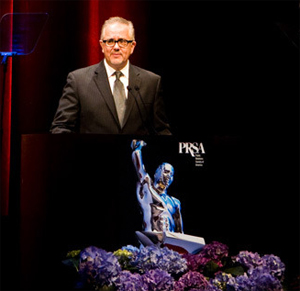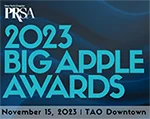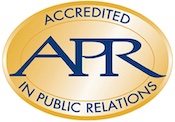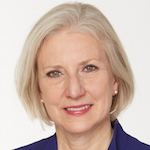The No. 1 topic among PR people is no doubt what exactly is PR? Each PR person has a different definition.
PR Society of America went on a worldwide quest for a new definition in 2011 after chair Rosanna Fiske told New York Times ad columnist Stuart Elliott Nov. 20, 2011 that she could not explain PR to her parents.
 Mickey Nall |
It does not. It seeks to do that. The “definition” was more of a wish than a definition.
Dave Rickey, 2011 secretary, commented on the furor that developed as a result of this quest in the Spinsucks blog of Feb. 15, 2012.
Mickey Nall, 2013 chair, has now come up with a more exacting definition in connection with the 2013 Silver Anvil Awards that were given out on June 13.
Photo coverage of the event was excellent. The only problem with all the photos is that no idents are provided. This sort of laziness and amateurism belongs at local golf and social clubs.
The picture posted on the Society website of grand prize winners DuPont and Ogilvy showed eight people grinning and holding Anvils. But it's a mystery as to who they are.
Media relations costs of the Society for 2102 were $619,552 and included $393,253 for pay/fringes. Staff are not doing the basics of their jobs.
Uniform standards for providing identification are a pressing need at the Society. Best idents of leaders are on the New York chapter website where the chapter provides name, company, title, phone, e-mail spelled out, and cell-phones and faxes in some cases.
The worst idents we have seen are at Nall's own chapter, Georgia, the second biggest with nearly 900 members. Names and companies of the board are provided but no titles, phones or e-mails (not even click-throughs to e-mails). Why are they hiding?
The biggest chapter, National Capital, with nearly 1,500 members in it area, has similar shortcomings.
Nine officers are shown and give their phone numbers but not their employers, titles or e-mails, not even click-throughs.
The other 12 directors mostly provide phones and e-mails but no employers or titles.
The Society has a "Board of Ethics and Professional Standards" but standards for identification of leaders are lacking for the 112 chapters.
'Measurable Results' Needed, Says Nall
Anvil entries, said Nall in a release before the Anvils event, "must have specific, measurable, achievable, realistic and timely objectives, demonstrate tangible contribution to the organization, impact the target audience in a desired way, and link PR activities to specific business outcomes that support organizational goals."
Anvil instructions warn that merely showing up with a bushel of press clippings will earn nothing but the disdain of the judges. No, you have to show goals, strategy, implementation and measurement. All four elements have to be present and if you are wise they will be four equal parts of your entry.
Goals and measurements are fine but they miss what the media are for—community recognition.
A family business that gets written up in the local paper has earned recognition that is an end unto itself. The article doesn’t have to sell more of whatever the family is selling. Everything has been accomplished with the article. No measurement is needed.
Public notice is the main goal of PR and clients should not let their heads be spun by all that talk of strategy, goals, objectives and proven results.
PR brings attention to a product or service but the product or service has to be competitive in quality and price. Talk about strategy, etc., just takes the client’s eye off the ball and is close to being double-talk.
Since the Society is so hooked on measurable results, can it show that Anvil winners get more business or better jobs? Where is the study of that?
PR counselors tell us that clients should decide what they want from PR and what they deem to be a successful campaign.
Nall's Definition Fits Advertising
Nall's definition fits advertising where impressions can be measured and linked with sales. Ads are lucky to get a fraction of a second of interest from readers or viewers. They need a simple, graphic, hard-hitting message.
But a good article already has the reader's undivided attention and he or she is looking for details, details and more details. Portions of the PR industry have to rescue themselves from the bean counters who have mostly isolated themselves from press questions.
No better examples exist than the two biggest conglomerates and the Society itself.
Wren, Weisenburger Got $91M
John Wren, CEO of Omnicom, made No. 11 on Bolt Insurance's "Highest Paid CEO" list with 2012 pay of $42.6M which is even more than No. 12 made -- Jamie Dimon of JPMorgan ($41.9M).
We figured Wren's actual compensation at $47.3M based on his insider trading profits.
PR people should eyeball the insider trading stats themselves.
They will see Wren sold stock worth $81M in transactions in March 2012 ($29M, $20M, $12M and $11M) and August ($6.9M, $3.4M and $4.6M). They can see what he paid for this stock by exercising options.
A close second and getting CEO-level pay is CFO Randall Weisenburger, selling stock worth $44.9M. He should be on the Bolt list of high-paid execs since No. 15, Howard Schultz of Starbucks, only made $41.4M. We figure Weisenburger’s 2012 total pay at $44.3M. Both he and Wren are accountants by occupation.
Why aren't the creatives making this sort of money? The board which seconds these amounts are all either financial or corporate types.
Others listed as the top paid people at OMC are SVP-finance Philip Angelastro ($2.1M), SVP-general counsel Michael O'Brien ($1.7M), and treasurer Dennis Hewitt ($1.1M).
Murray, Bonaventura Have Top PRS Pays
The PR Society, which like OMC has a press-resistant policy, has a staff headed by association executive Bill Murray whose pay package was $382,013 in 2011. CFO Philip Bonaventura took in $235,797.
A legal, accounting-driven culture dominates at Society h.q. instead of a PR culture. Legal costs for the seven years to Dec. 31, 2011 were $558,264.
The pay figures are for 2011. Staff and the board refuse to give out the pay totals for 2012 although the audit has been published and there is no excuse for withholding that data. If past practice holds, members won’t get it until November and only if they go to h.q. themselves or make a written request.
The Society has now hired the Organizational Performance Group of Hamden, Conn., to help it win more interest in APR which will be 50 next year and is showing signs of age (157 new APRs yearly from 2003-2012 vs. 256 yearly from 1993-2000).
Coincidentally, OPG, headed by Laura Freebairn-Smith, is only a short distance from Quinnipiac College, where Kathy Fitzpatrick is a PR professor and author of two articles on the revised Society Code.
The Society spent $50,554 on the Ethics Resource Center of Washington, D.C., but ignored its advice to retain enforcement in the Code. That was also the view of members.
We have asked Freebairn-Smith and Fitzpatrick whether they know each other and have asked Freebairn-Smith if she will contact Fitzpatrick, who was a member of the Ethics Board when the Code was re-written. Neither has responded to those questions. Fitzpatrick should give Freebairn-Smith a copy of the ERC ethics study.
What the Society needs as an outside consultant is something it has never had -- a PR firm. A PR firm could not duck the press the way the Society does. PR’s first job, Harold Burson said on receiving the PR Foundation’s Paladin Award in 2011, is listening.


 PRSA-NY today announced its five honorary co-chairs for its Big Apple Awards ceremony gala slated for TAO Downtown on Nov. 15.
PRSA-NY today announced its five honorary co-chairs for its Big Apple Awards ceremony gala slated for TAO Downtown on Nov. 15. PRSA-NY president Carmella Glover today issued a "heartfelt apology" on behalf of the chapter for her Oct. 14 message that "caused disappointment and hurt to some of our valued members."
PRSA-NY president Carmella Glover today issued a "heartfelt apology" on behalf of the chapter for her Oct. 14 message that "caused disappointment and hurt to some of our valued members." The leadership of Public Relations Society of America is backing a move to change the current “must-have” APR accreditation to “strongly preferred” as a requirement for a seat on its board of directors.
The leadership of Public Relations Society of America is backing a move to change the current “must-have” APR accreditation to “strongly preferred” as a requirement for a seat on its board of directors. Public Relations Society of American today named Linda Thomas Brooks CEO, succeeding CFO Phil Bonaventura, interim chief since July 2019.
Public Relations Society of American today named Linda Thomas Brooks CEO, succeeding CFO Phil Bonaventura, interim chief since July 2019.


 Have a comment? Send it to
Have a comment? Send it to 
No comments have been submitted for this story yet.